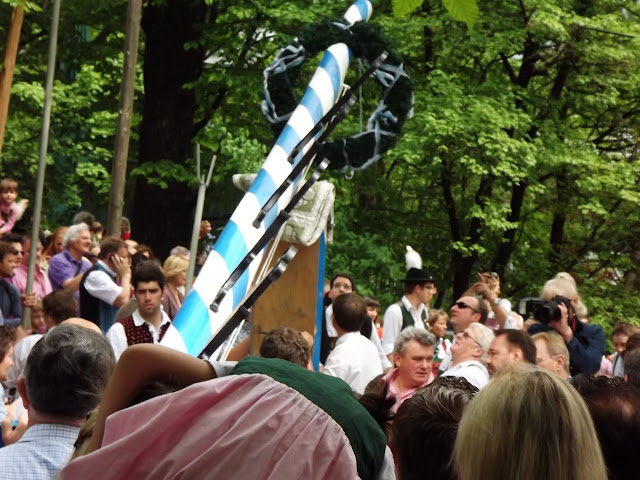Her first piece of advice to her tour was to tell them to turn around and look at all the tourists holding their cameras, waiting for the action. The bells ring for a long time before the characters in the clock start to move... she advised them to watch as the arms holding up the heavy cameras start to droop, the brows start to sweat... then turn around when the clock actually starts to do something. She also told us about the armored cherubs surrounding the pillar holding the statue of Mary. They are battling various beasts.
One -- a chicken (??!!) -- represents the Black Plague. It turns out that the people of Munich thought the plague was caused by a Basilisk... but eventually they realized that lots of people were dying and nobody had seen a Basilisk. After awhile, they decided the problem was cats, so they killed them all off, leaving the real culprits -- rats -- to proliferate. Eventually they figured that out and went to Italy to import cats. "If you listen closely, you'll discover that to this day, all the cats in Munich say 'meow-a.'"
A second is a lion, which represents fear. The third is a dragon, which represents starvation. And the fourth is a snake, which represents heresy, "which basically means Protestantism."
We also learned some new things about the Glockenspiel. There are two obvious moving parts (see picture below). The top tableau shows a wedding feast for the Duke(?) of Munich, which includes dancers and a joust, in which the king of Austria is unhorsed. Immediately after that plays out, there's a lower tableau featuring the cooper's dance, Coopers are barrel-makers, whose trade is dependent on beer. During the plague, nobody came out, which meant nobody went to the bier halls, which meant that nobody sold beer, which meant that nobody needed barrels. The coopers dance actually originated when the guild decided to come out and dance to show everyone that the plague was over and it was OK to go back to the pubs. The Duke was so impressed that he ordered that the dance be repeated every 10 years. It is to this day, and in fact was danced in January 2012 (if I remember correctly).
We also saw something we'd never noticed before. At the end of the Glockenspiel show, after the wedding feast and the cooper's dance, there's an owl way up at the top that comes forward and flaps his wings.
Afterwards, we went back to the Viktualienmarkt (food market) for a giant pretzel and final Augustiner Dunkel beer. While there, we saw a group of older men having beer, pretzels and other snacks. A family came by and the older gentlemen offered pretzels to their kids, after checking with the parents, of course.
The Lufthansa flight back to Dulles was great. From there, not so great. United Airlines did not move up in my estimation. But I don't want to end on that sour note.
Instead, here are some more contemplative closing thoughts.
A theory is growing on me. It's that if every town had a bier garten and/or outdoor cafe every few blocks, it would be a much mellower world. In Austria and Germany, people sit out in a cafe at any time of the day or night, pretty much regardless of the weather. If it's cold, there are blankets or sheepskins to put on your lap. If it's raining, you put up the table umbrella. And have a coffee, or a beer, or a glass of wine. Or ice cream. We saw lots of folks bundled under blankets, eating ice cream.
I am no way implying that mellowing out requires alcohol, although maybe stopping in the middle of the day for a beer or glass of wine isn't an entirely bad idea. Yes, we saw people having beer at 9:00 in the morning, next to the other folks drinking coffee. But in all our travels in German-speaking Europe, I have seen only one drunk. Probably a tourist. A tourist with a problem. Nobody's rowdy or mean. Nobody's sloppy, and they're certainly not lazy (they power wash the inside of their outdoor trash cans, for crying out loud!). But it's Ok to stop and have a beer. Generally one. And to sit out and enjoy the day, even if it's 40 degrees and raining. Just pull up a blanket and get under the umbrella. Chill out. Figuratively, and maybe very literally.
And offer a pretzel to a kid.
We saw much in Europe to be admired, and things I'd love to see our culture copy from Germany, Austria, and Italy. Not so sure about Lichtenstein, but we weren't there long enough to form an opinion. That said, there is much to be admired in the U.S., and much that is admired. Not always what we intend.
I mentioned that our last night in Augsburg, I had Spargel Suppe (yeah, I know, enough with the Spargel). After dinner I commented to the waitress on how wonderful the meal was and that we have nothing like their Spargel Suppe in America. Her reply:
"Yes, but you have lots of steak. And hamburgers."
(Fair enough. I haven't had beef in 5 weeks. Too expensive.)
Then her eyes got really wide... "and you have Taco Bell!!"
God Bless America!
























































